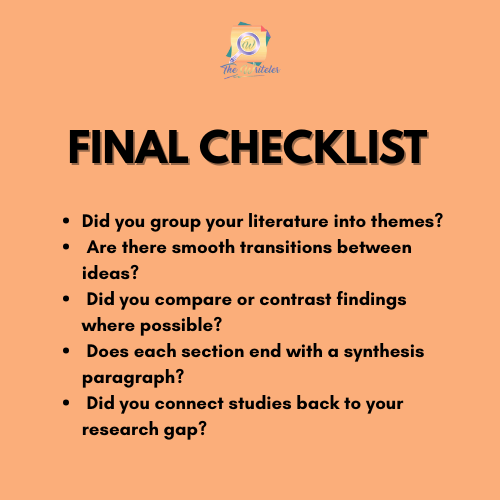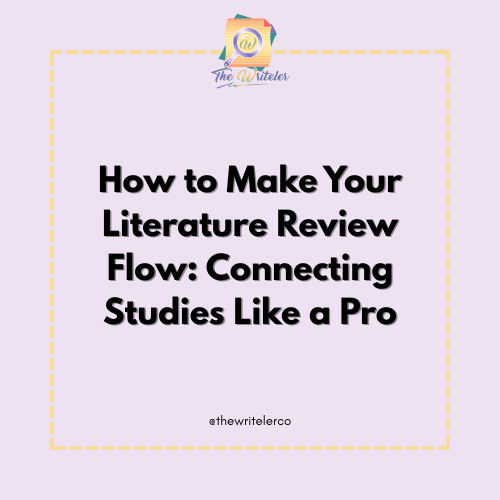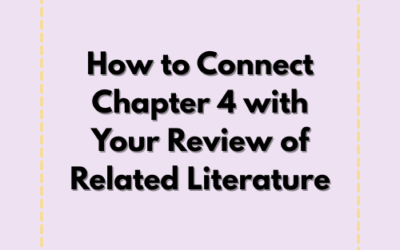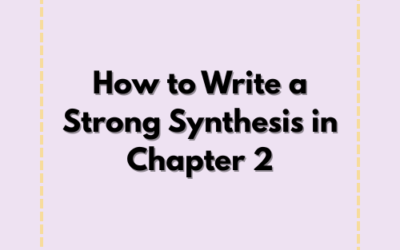So, you’re writing Chapter 2 of your thesis — the Literature Review. You’ve gathered the studies, highlighted the findings, and started writing. But something feels off.
Your paragraphs read like this:
“Author A (2019) said this. Author B (2021) also said something similar. Meanwhile, Author C (2020) disagreed.”
It feels more like a checklist of citations than a meaningful discussion.
Here’s the truth: a strong literature review doesn’t just list studies — it connects them. It flows like a story, building themes, comparing insights, and pointing directly to the gap your study will fill.
In this guide, we’ll show you how to make your literature review flow smoothly — so your Chapter 2 feels smart, structured, and defense-ready.
What Does It Mean for a Literature Review to “Flow”?
Flow refers to how smoothly one idea transitions to the next — how your paragraphs, themes, and studies work together to support your research.
A flowing literature review:
- Groups ideas by theme, not author.
- Uses transitions and comparisons between studies.
- Has a clear direction from start to gap.
- Feels like a conversation, not a collage.
Without flow, even a well-researched Chapter 2 can feel like a disconnected mess.
Signs Your Literature Review Lacks Flow
🚫 You summarize one study per paragraph.
🚫 Your transitions are weak or missing.
🚫 There’s no comparison or contrast between findings.
🚫 It’s unclear how each section supports your research.
If any of these feel familiar, don’t worry — we’ve got you covered.
Step-by-Step: How to Make Your Literature Review Flow
✅ 1. Start with a Thematic Outline
Instead of organizing your literature by author or year, group them by relevant themes or variables.
Let’s say your topic is “Mindfulness and Academic Performance in Senior High School Students.”
Your themes might look like:
- Theme 1: Definitions and Models of Mindfulness
- Theme 2: Mindfulness in Education
- Theme 3: Academic Performance Factors
- Theme 4: Connections Between Mindfulness and Academic Performance
This structure immediately gives your review flow.
✅ 2. Use Transitional Phrases and Bridge Sentences
Avoid abrupt shifts like: “Author A said this. Author B disagreed.”
Instead, try:
- “Similarly, Author B (2021) found…”
- “In contrast, Author C (2020) emphasized…”
- “Building on these findings…”
- “This pattern suggests that…”
These phrases guide the reader and glue ideas together.
✅ 3. Compare and Contrast Findings
The literature review isn’t just a highlight reel — it’s an analysis.
Ask yourself:
- Do any studies agree or disagree?
- What patterns or trends are emerging?
- Which methods or contexts lead to different results?
Then, write about those relationships.
Example:
“While Santos (2021) and Reyes (2022) both highlight the positive effects of mindfulness on focus and memory, Cruz (2023) notes that the impact may vary depending on students’ baseline stress levels, suggesting the need for more contextualized studies.”
✅ 4. Relate Studies to Your Research
Your literature review isn’t a general summary — it should always lead back to your study.
Use reflective sentences like:
- “These findings highlight the gap in research for high school populations in rural areas.”
- “This supports the need for a localized intervention study, which this research addresses.”
These sentences remind the reader why all this reading matters.
✅ 5. End Sections with a Synthesis
After each theme or section, write a paragraph that:
- Summarizes key findings
- Acknowledges any gaps or limitations
- Connects the theme to your research objectives
Example:
“Overall, the literature supports the use of mindfulness in improving academic performance. However, most studies focus on university students in Western countries, highlighting a research gap this study aims to fill among Filipino high school learners.”
This gives your section closure and sets up what’s coming next.
Writing Techniques to Strengthen Flow
📝 Use topic sentences to introduce each paragraph’s focus.
🌀 Vary your sentence structure to keep the reader engaged.
📌 Keep your research questions visible while writing.
📋 Use parallel structure when comparing multiple studies.
These small adjustments make your review easier to read and more compelling.
Before-and-After Example
❌ Weak Paragraph (No Flow):
“Santos (2020) said mindfulness helps students. Dela Cruz (2021) studied the same topic but focused on stress. Meanwhile, Kim (2022) found different results with college students.”
✅ Improved Paragraph (With Flow):
“Santos (2020) emphasized the role of mindfulness in improving student focus and memory. Similarly, Dela Cruz (2021) found that mindfulness reduced stress levels among high school learners, indirectly supporting academic performance. However, Kim (2022), studying college students in a high-pressure environment, found no significant effects, suggesting that context and population play a crucial role. These mixed findings highlight the need for further research among younger learners in localized settings.”
See the difference? The ideas build on one another, forming a clear argument.
Common Pitfalls to Avoid
🚫 Listing studies without transitions
🚫 Using direct quotes instead of synthesis
🚫 Jumping from one theme to another without warning
🚫 Not linking the literature back to your study

If you answered yes — you’re flowing like a pro.
📣 Need Help Making Your Literature Review Flow?
The Writeler Co. is here to support students and professionals who are juggling research with work, life, and business. Whether you’re writing a thesis, capstone, or dissertation for your master’s or Ph.D., we help you efficiently navigate the research journey — from brainstorming to proofreading.
📩 Message us today to get started.
📚 Let’s turn your research idea into a powerful paper.





0 Comments